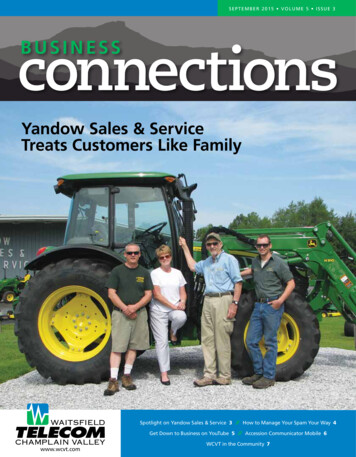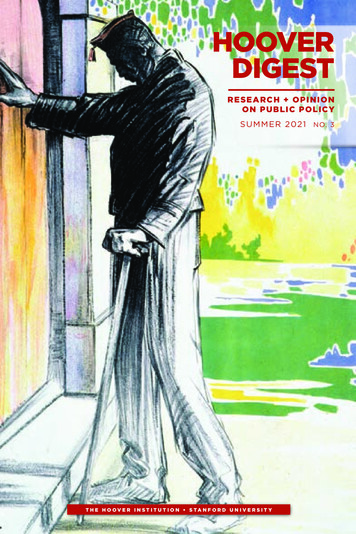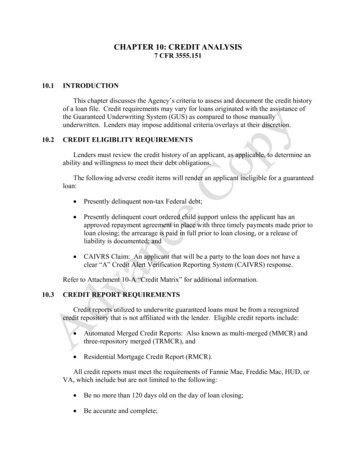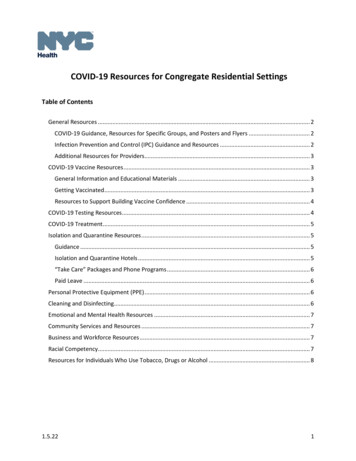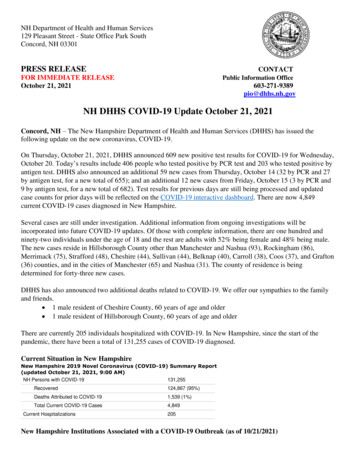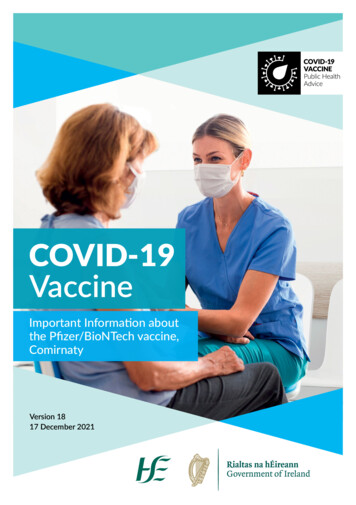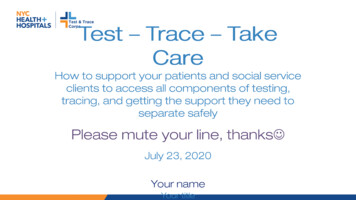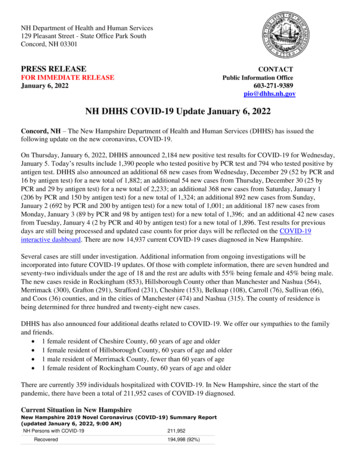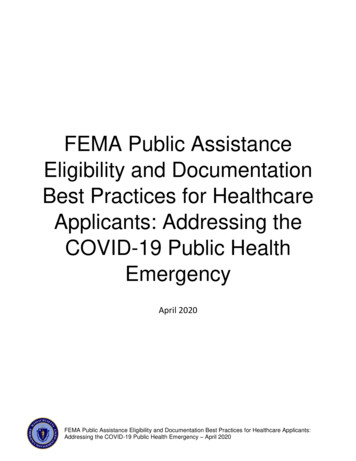
Transcription
FEMA Public AssistanceEligibility and DocumentationBest Practices for HealthcareApplicants: Addressing theCOVID-19 Public HealthEmergencyApril 2020FEMA Public Assistance Eligibility and Documentation Best Practices for Healthcare Applicants:Addressing the COVID-19 Public Health Emergency – April 2020
Table of Contents:I.II.III.IV.Introduction: Components of eligibility relevant to Public Assistance Category B EmergencyProtective Measures Grant Fundinga. Overview of the Eligibility Pyramidb. FEMA’s COVID-19 Specific GuidanceCost Eligibility Documentation Best Practices and Common Mistakesa. Overviewb. Duplication of Benefits, Deductions, and Donated Resourcesc. Force Account Labord. Force Account Equipmente. Force Account Materialsf. Contract CostsCost Eligibilitya. Summaryb. Cost Eligibility Documentation Best Practices and Common Mistakesi. Force Account Laborii. Force Account Equipmentiii. Force Account Materialsiv. Contract CostsAppendicesa. Appendix 1: Applicant Eligibilityi. Eligibility for Private Nonprofit Organizationsii. Eligibility for Mixed Profit/Nonprofit Medical Facilitiesiii. Eligibility for Public Entitiesb. Appendix 2: Facility Eligibilityi. Private Nonprofit and Mixed Facilitiesii. Public Facilitiesc. Appendix 3: Work Eligibilityd. Appendix 4: Key Department of Homeland Security Office of the Inspector General FEMAPublic Assistance Auditse. Appendix 5: Cost Eligibilityi. 2.a. Emergency Work Cost Eligibilityii. 2.b. Emergency Work Eligible Costs for COVID-19 Responseiii. 2.c. Emergency Medical Care Fact Sheetf. Appendix 6: Procurement Requirements and ExceptionsFEMA Public Assistance Eligibility and Documentation Best Practices for Healthcare Applicants:Addressing the COVID-19 Public Health Emergency – April 2020
I. Introduction:The purpose of this document is to outline FEMA eligibility and cost documentation best practices forhealthcare applicants and FEMA Public Assistance (PA) applicants within the context of the currentCOVID-19 emergency response. Applicant, facility, and work eligibility details can be found inappendices 1, 2, and 3.Healthcare and Medical Care Facilities are on the front lines combating the COVID-19 Public HealthEmergency. Public and certain private nonprofit (PNP) hospitals are eligible to apply for FEMA PACategory B Emergency Protective Measures Funding. These best practices are based on federalregulations, the Public Assistance Program and Policy Guide (PAPPG), FEMA’s COVID-19 specificguidance1, Inspector General audits, and years of experience on supporting FEMA grant programs. Seeappendix 4 for some key Department of Homeland Security Office of the Inspector General Audits ofFEMA’s Public Assistance programs, which address several common mistakes made in the past byhospital, private nonprofit, and other applicants. All applicants should thoroughly read FEMA’s COVID-19Streamlined Project Application guidance in order to understand the exceptions to existing FEMA PublicAssistance policy and how FEMA is applying policy to the unprecedented COVID-19 public healthemergency.2Public Assistance grants are subject to specific eligibility requirements. FEMA assesses eligibility at fourlevels: applicant, facility, work, and cost and refers to these as the “building blocks” of the eligibilitypyramid. FEMA typically starts at the bottom of the pyramid, first assessing applicant eligibility andworking up to the top of the pyramid, ending at eligible costs. For private nonprofits (PNPs), the Stateand FEMA will determine whether the PNP applicant is eligible by reviewing its proof of nonprofitstatus. Subsequently, FEMA will determine which facilities can be included, which will in turn limit whichwork is eligible. Only work performed at eligible facilities will be considered eligible. In the case ofCOVID-19 response, all work must be addressing an immediate threat. Eligible costs are considered lastand include labor, equipment, and materials of the applicant (force account labor, equipment, andmaterials) as well as contract costs.1FEMA has released guidance on activities and costs eligible for PA funding including: FEMA’s Public Assistance Program andPolicy Guide (PAPPG); FEMA Fact Sheet Coronavirus (COVID-19) Pandemic: Eligible Emergency Protective Measures; FEMAFact Sheet: Coronavirus (COVID-19) Pandemic: Emergency Medical Care; FEMA Fact Sheet: Public Assistance: Non-CongregateSheltering Delegation of Authority; FEMA Fact Sheet: Coronavirus (COVID-19) Pandemic: Non-Congregate Sheltering- FAQ;FEMA Fact Sheet: Procurement Under Grants: Under Exigent or Emergency Circumstances; FEMA Fact Sheet: Coronavirus(COVID-19) Pandemic: FEMA Assistance for Tribal Governments; FEMA Fact Sheet: Coronavirus (COVID-19) Pandemic: PrivateNonprofit Organizations. Visit FEMA’s News Release page for additional resources as new materials are released on a dailybasis.2Submitting a Public Assistance Funding Request for COVID-19: FEMA Public Assistance COVID-19 Streamlined ProjectApplication. April 10, 2020.FEMA Public Assistance Eligibility and Documentation Best Practices for Healthcare Applicants:Addressing the COVID-19 Public Health Emergency – April 2020
II. Cost EligibilityAfter an applicant, facilities, and work is deemed eligible, the eligibility of specific costs must beanalyzed. The following section outlines four main categories of costs: force account labor, force accountequipment, force account materials, and contract costs. Costs must be reasonable and equitable for thetype of work performed.Duplication of Benefits, Deductions, and Donated Resources:All eligible costs will be reduced by all other funding and revenue sources and the remainder will becovered by FEMA Public Assistance, which is considered the funding of last resort. This includes coststhat are covered by insurance policies, other federal funding streams such as Health and HumanServices (HHS) and Centers for Medicare and Medicaid Services (CMS), as well as any recoveredsalvage costs.3 In section IV of the FEMA COVID-19 Simplified Project Application, applicants will certifythat benefits are not duplicated and that if they do receive funding from another federal source, they willnotify the Recipient (state) and FEMA to initiate a funding reconciliation. Applicants will account for theirdeductions including insurance, donated resources, etc. in Section 3 of Schedule A of the COVID-19Simplified Project Application.4Donated resources can be used as an offset to the non-federal match (25%) of the FEMA PA program aslong as the donated resources are from a third party, the resources are used to perform eligibleEmergency Work, and the applicant tracks the resources and work performed (description, locations, andhours). Eligible donations include labor, equipment, supplies, and cash donations used for theemergency response activities. See pages 35 and 36 of FEMA’s Public Assistance Program and PolicyGuide (PAPPG) for additional details.Documentation Requirements:Initial cost documentation requirements for expedited projects are much lower than for regular projects;however, it is best practice to apply for an expedited project with as much information as possible. Table1 below outlines the minimum documentation needed to submit a project worksheet (PW) based onestimates for expedited payments as well as the documentation for subsequent PW versions based onactuals. The following sections outlining best practices for eligible cost categories are based on long termdocumentation requirements based on actuals that will ultimately be needed to substantiate the initiallyestimated costs in later versions of PWs.Applicants should review and complete Schedule C and Schedule D of the FEMA COVID-19Streamlined Project Application for in progress work estimates including cost eligibility anddeductions and Large Project Eligibility Questions respectively (pp. 15 – 25).34FEMA PAPPG, pp. 39- 41COVID-19 Streamlined Project Application, pp. 7—8 and pg. 11FEMA Public Assistance Eligibility and Documentation Best Practices for Healthcare Applicants:Addressing the COVID-19 Public Health Emergency – April 2020
Table 1. Summary of Cost Categories and Required DocumentationCostCategoryMinimum for PW Version 0(Estimate)Documentation for Subsequent PW Versions(Actuals)ForceAccountLabor Number of personnel;average hours perday/days per week; Average pay rate (If none,FEMA will estimate 20 perhour.) Name of employee, job function, title, type ofemployee Timesheets, Days and Hours worked,description of work performed and activity log,Labor summaries Proof of payment and pay rate schedules Labor policiesForceAccountEquipment Amount and type ofequipment used, averagehours per day/days perweek, and hourly rate Rented: rental agreementand pricing Type of equipment including, year, make, andmodel Size or capacity of equipment Hours worked, including the location and day Usage and operator Schedule of ratesMaterials,Supplies Amount and type ofmaterials; purchase orstock replenishment cost Material usage and inventory withdrawalrecords including the types of supplies andquantities used Purchased equipment proof of payment andinvoices (such as ventilators)ContractCosts Copy of request forproposals, biddocuments/signedcontracts InvoicesContractsProof of paymentBid documentsCommon challenges and mistakes across all cost categories and across many types of applicantsinclude:1) Improper accounting of disaster versus non-disaster funds: This includes but is not limited to, nottracking FEMA disaster funding by project, comingling of FEMA disaster funds with other costs, orintentional use of disaster funds for ineligible costs.2) Insufficient or missing proof of payment for eligible costs: Most often proof of payment will bemissing or insufficient for contract work or labor due to the accounting system of some applicants.For example, some applicants provide “proof of payment,” that is an excel output from theirinternal accounting system as opposed to documentation verified by a third party such as acancelled check or bank transfer statements.3) Inclusion of ineligible costs including but not limited to costs for work performed outside of theperiod of performance or project scope of work.4) Violation of labor policies such as requesting reimbursement for overtime that was not approvedby a supervisor when an applicant’s labor policy requires prior approval.5) Insufficient documentation to support costs such as missing or inadequate timesheets, equipmentand supply usage logs, invoices, contracts, and proof of payment.6) Not following federal procurement standards following the conclusion of the exigent or emergencyperiod.7) Duplication of benefits of funds from other Federal sources such as HHS and CMS.FEMA Public Assistance Eligibility and Documentation Best Practices for Healthcare Applicants:Addressing the COVID-19 Public Health Emergency – April 2020
Force Account Documentation Best Practices: Force Account LaborWhat force account labor costs are eligible for Category B Emergency Protective Measures. Certaincategories of eligible medical facilities’ own employees labor related to the COVID-19 response will bereimbursable if tracked and documented correctly.Force Account Labor eligibilityHours of work completed by the applicant’s personnel who complete the scope of work within a project.All hours and employees charged must be eligible work for FEMA Public Assistance Category Bgenerally (appendix 5a) and based on COVID-19 specific guidance described in appendices 5b and 5cbelow.Generally permanent and emergency work are eligible, but for the COVID-19 response, only emergencywork is eligible: For budgeted employees doing emergency work, only overtime labor costs are eligible.For unbudgeted employees doing emergency work, both straight time and overtime labor costsare eligibleEmergency Work Cost Eligibility (Page 24 PAPPG)Cost Eligibility is determined by: Severity of the incidentWhether work was performed at a time when extraordinary hours were necessaryThe function of the employee for which the hours are claimedThe number of consecutive hours the employee workedFEMA Public Assistance Eligibility and Documentation Best Practices for Healthcare Applicants:Addressing the COVID-19 Public Health Emergency – April 2020
Required Labor Documentation: The table below outlines key categories and their sub-categories ofnecessary documentation as well as best practices based on FEMA policy guidance and FEMA SMEs.Note that the quality and detail of documentation for force account labor are key in ensuring all eligiblecosts are covered.CategoryDocumentationDetailsBest PracticesCommon ErrorsEmployeeDetailsNameFEMA needs to know ifemployees are budgeted,unbudgeted, hourly,exempt, etc. Temporaryemployees hired forCOVID-19 response, ormedical professionalsworking on other medicalissues will have differentrequirements.Timesheets must be“signed” physically orelectronically by theemployee and by theirsupervisor. Electronicsignatures includeapproval through an onlinetime tracking system.Applicants should log allhours performed.If an employee is alsoworking on other work, adifferentiation in type ofwork being performedmust be clear ontimesheets and laborsummaries as straighttime will not be eligible inall cases.Clearly track each employee’scategory and job function(s).This information should beclearly noted on theirtimesheets for ease ofvalidating that their pay rate isbeing charged correctly and isin line with labor policy.Failing to properlytrack the type ofemployee makes itchallenging forauditors todetermine if straightor overtime areeligible.Verify timesheet approvalpractices used for FEMAfunded activities follow bothFEMA rules (signed byemployee and their supervisor)as well as company’s own laborpolicies. Activity descriptions arenecessary to validate thekind of labor performed.This is also necessary forlogging any equipmentusage for force accountequipment.Labor summaries, liketimesheets, must also besigned and verified by asupervisor or accountant.Track hours worked, activitiesperformed, and equipmentused on a single form to ensureuniformity in claims and avoidaccidentally claimingequipment usage for incorrectdates, times, and staff.Ensure labor summariescorrectly capture employee’sinformation in line with FEMArequirements and company’sown labor policies. If suchsummaries do not exist, usethe labor summary formsprovided by FEMA forapplicants to use.Job FunctionTitleType ofEmployeeTrackingtimeTimesheetsDays and hoursworkedDescription ofwork performedwith activity logLaborSummariesSet up a separate chargecode for COVID-19 responsewill differentiate what hourscan be included in aCategory B project. Hourlyand fulltime salaried staffmay usually track their timedifferently; however,distinction in time used forCOVID-19 specific activitiesis vital for FEMAreimbursement. Timesheets thatare illegible, notsigned, orverified byapplicantmanagement.Notdifferentiatingbetween type ofwork activitiescommonlyoccurs. Staff inmedical facilitieswill be workingon both eligibleand ineligibleactivities.Tracking hourswithout clearlydifferentiatingovertime andstraight timecreatesproblems whenonly overtimecosts arereimbursable.See DHS OIG Auditreport of RiversideHospital in Texas foran example of anapplicant notdelineating disasterand non-disastercosts.FEMA Public Assistance Eligibility and Documentation Best Practices for Healthcare Applicants:Addressing the COVID-19 Public Health Emergency – April 2020
PaymentLaborpoliciesProof ofpaymentEmployee paymentverification is necessaryfor hours validation.Use an easily trackableelectronic payroll system. Keepthird party verifiable proof ofpayment records such ascancelled checks or banktransfer records.Pay rateschedules andfringe benefitrateApplicant must providepay rate schedules for allcategories of employeesas well as fringe benefits,their rates andcalculations.Compile clear pay rateschedule and fringe benefit rateinformation for each category ofemployee bydepartment/administrativestructure of the hospital (seeAppendix 1 for categories ofemployees).Pay policiesApplicant must provide alllabor policies related toovertime and benefits forall categories ofemployees.Conduct a review of all relevanthospital human resources, pay,overtime, and benefit policies toverify policy compliance. FEMAwill only reimburse based on anapplicant’s pre-existing paypolicies. If an applicant’s paypolicy does not pay time and ahalf for overtime, FEMA will notcover that time. See DHS OIGAudit report of Napa StateHospital, California for anexample of an applicantviolating its own labor policies.Overtime andbenefit policiesProviding insufficientor unverifiabledocumentationFor example:Applicants mightprovide an excel file“output” from theirinternal accountingsystem that lackspayment transfertracking numbers. Providing payrate schedulefor only somedepartments ofemployees. Only providingfringe benefitrates for certainemployeesIncluding labor costson PW not normallycovered by theapplicant’s labor andpay policies.FEMA Public Assistance Eligibility and Documentation Best Practices for Healthcare Applicants:Addressing the COVID-19 Public Health Emergency – April 2020
Force Account Documentation Best Practices: Force Account EquipmentForce Account Equipment Eligibility:What force account equipment costs are eligible for Category B Emergency Protective Measures.Certain categories of eligible medical facilities’ equipment usage related to the COVID-19 response willbe reimbursable if tracked and documented correctly.Applicant-owned equipment used to complete the scope of work within a project, including permanentlymounted generators, based on hourly rates. All equipment usage must be eligible work for FEMA PublicAssistance Category B and based on COVID-19 specific guidance. FEMA provides PA funding forapplicant-owned equipment based on hourly rates, funding based on mileage for vehicles, if the mileageis both documented and is less costly than hourly rates.In situations where applicants have insufficient equipment to respond to the disaster, FEMA will providePA funding for: the purchase price of the equipment and the use of the equipment or the actual fuel andmaintenance costs.Section 2 of Schedule C of the FEMA COVID-19 Streamlined Project Application includes supplies orequipment that might be used in treating COVID-19 patients. Example items include in vitro diagnosticsupplies, respirators, N95 respirators, medical gloves, surgical masks, medical gowns, coveralls, faceshields, other personal protective equipment (PPE), decontamination systems, ventilators and productsmodified for use as ventilators, and therapeutics.”5Equipment Rates: Equipment rates are reimbursed based on the time the Applicant is operating theequipment. Only intermittent standby time is eligible if the operator uses the equipment intermittently forover half of their working hours on a given day. Note that equipment, such as generators do not requirean operator, are also eligible.FEMA establishes equipment rates on a national basis, which includes any item powered by fuel orattached to an item powered by fuel. Rates include costs associated with ownership and operation ofequipment, except labor. Rates incorporate depreciation, overhead, equipment overhaul, maintenance,lubrication, tires, ground engaging components and fuel. FEMA will honor State and Territorial Rates,Tribal Rates, or local rates in addition to the FEMA established rateEquipment without an Established Rate: The applicant can either propose a rate for approval by FEMAor request FEMA develop and provide a rate to them. Rates submitted by applicant must be in line withcurrent market prices and cannot include cost components such as profits that are not directly involvedwith operating and maintaining the equipment.Required Equipment Documentation:CategoryDocumentationDetailsBest PracticesCommon ErrorsEquipmentOperatorNameFEMA needs to knowwhich employees areoperating whichequipment in order tovalidate its usage. Theexception to this isequipment that does notrequire an operator.Clearly track each employee’scategory, job function(s), andtime worked as well as anyequipment utilized during theirtime worked. This informationshould be clearly noted on theirtimesheets for ease ofvalidating that their pay rate isApplicants who donot organizeequipment utilizedwith time worked byindividualemployees will oftenattribute equipmentusage to the wrongJob FunctionTitleTime worked(see below)5COVID-19 Streamlined Project Application, pg. 20.FEMA Public Assistance Eligibility and Documentation Best Practices for Healthcare Applicants:Addressing the COVID-19 Public Health Emergency – April 2020
being charged correctly and isin line with labor policy.EquipmentDetailsYear, make, andmodelSize andcapacity ofequipmentSchedule ofEquipmentRatesTrackingtimeFEMA reimburses forequipment usage basedon type and size of vehicleand FEMA’s schedule ofequipment rates from themost recent year or STTLequipment rates.TimesheetsSigned and verifiedtimesheets must beprovided for eachequipment operator inorder to verify the timeworked.Days and hoursworkedAll time should becorrectly tracked andattributed to theappropriate activity.Description ofwork performedwith activity logMust include location andtime of work performed aswell as equipment used.Example: Document hoursworked, equipment used, andactivity log within eachindividual employee’stimesheets.Applicants should clearly trackequipment used by eachemployee in accordance withtheir hours worked.Additionally, they shoulduniformly use one schedule ofequipment rates. The bestpractice is to use FEMA’sschedule of equipment rates ifpossible. If a FEMA rate doesnot exist ensure a market rateis used and approved byFEMA.See DHS OIG Audit report ofJefferson Hospital in Metairie,Louisiana for an example ofimproper documentation.Verify timesheet approvalpractices used for FEMAfunded activities follow bothFEMA rules (signed byemployee and their supervisor)as well as company’s own laborpolicies.Set up a separate charge codefor COVID-19 response willdifferentiate what hours can beincluded in a Category Bproject.person or to thewrong day. Using FEMA’sequipment rateschedule basedon the capacityor size of thevehicle insteadof based on thecorrespondingname orequipment code.Failing to collectappropriatedocumentationon equipmentused.Not clearlydelineating disaster,in this case COVID19 relatedequipmentoperation, make itimpossible todetermine whichcosts are eligible.Track hours worked, activitiesperformed, and equipmentused on a single form to ensureuniformity in claims and avoidaccidentally claimingequipment usage for incorrectdates, times, and staff.FEMA Public Assistance Eligibility and Documentation Best Practices for Healthcare Applicants:Addressing the COVID-19 Public Health Emergency – April 2020
Force Account Documentation Best Practices: Force Account Material andSuppliesForce Account Material Eligibility:Materials and supplies are considered eligible if they are taken from the applicant’s stock and used forthe incident or are purchased and justifiably needed to effectively respond to and/or recover from theincident. In this case such supplies would be those utilized for response to COVID-19. For example,personal protective equipment (PPE) such as N95 masks previously purchased for the hospital, bututilized by the emergency room to protect staff against COVID-19 patients could be replaced/reimbursedby FEMA PA. Stock items will be reimbursed based on the applicant’s established method of pricinginventory or based on historical data or prices from area vendors if they lack an established method.For materials, equipment, and supplies that are purchased to meet the needs of the disaster, invoicesshould be provided. An example is the purchase of additional ventilators to meet the increased need forCOVID-19 patients. Items acquired through a contract with local vendors during the exigent period willnot have to be done through a competitive bidding process; however, items acquired after that time willneed to follow Federal procurement guidelines. Section 2 of Schedule C of the FEMA COVID-19Streamlined Project Application includes supplies or equipment that might be used in treating COVID-19patients. Example items include in vitro diagnostic supplies, respirators, N95 respirators, medical gloves,surgical masks, medical gowns, coveralls, face shields, other personal protective equipment (PPE),decontamination systems, ventilators and products modified for use as ventilators, and therapeutics.”6CategoryDocumentationDetailsBest PracticesCommon ErrorsMaterialusage andinventorywithdrawalrecordsTypes ofSuppliesFEMA will need to verifythe type(s) and quantitiesof supplies and materialsutilized in response to thedeclared disaster. Forsupplies that come fromthe applicant’s stock, theinventory system will serveas the proof of paymentand basis for costreimbursement.Sometimes applicants willneed to purchaseadditional equipment, suchas ventilators. Invoicesand proof of payment arerequired back updocumentation.Applicants who have a clearinventory withdrawal systemthat tracks the type and amountof supplies and how they areused will have the easiest timeproving the eligibility of theirmaterials costs. For applicantswithout such a system, theyshould collect historical dataand prices from vendors in theirarea.Equipment acquired during theexigent or emergency perioddoes not need to adhere toFederal procurementregulations in order to protectthe health and safety of theimpacted populations.Applicants should ensure thatequipment purchased througha contract outside of theexigent period were acquiredthrough a competitive biddingprocess. See FEMA Guidanceon Procurement Under Exigentor Emergency Circumstances.Use of unorganizedor unclear inventorymanagementsystems result in aninability to assesswhich supplies canbe reimbursed byFEMA.Quantities UsedAcquisitionandPaymentInvoicesProof ofpayment6Lack of appropriatedocumentationincluding invoicesand proof ofpayment is the mostcommon error forpurchased items.See DHS OIG Auditreport of JeffersonHospital in Metairie,Louisiana for anexample.COVID-19 Streamlined Project Application, pg. 20.FEMA Public Assistance Eligibility and Documentation Best Practices for Healthcare Applicants:Addressing the COVID-19 Public Health Emergency – April 2020
Contract Costs:Contract Cost EligibilityOutside of exigent and emergency circumstances, applicants must meet Federal procurement andcontracting requirements when receiving financial assistance under a Public Assistance project award.All costs associated with a contract of any kind, whether it is contracted labor, equipment purchases orrentals, materials/supplies require contract documentation and a competitive procurement processaccording to Federal procurement standards for State and Territorial governments (note standards forTribal governments, local governments, and private nonprofits differ, but most are universal). Inaddressing COVID-19, only Category B Emergency Protective Measures are eligible during this exigentand emergency period. OMB and FEMA have waived the Federal Procurement standards in order tosave lives. Applicants should note that after the exigent period has concluded, standard Federalprocurement rules will apply. Specifically, a contract awarded to a vendor during the exigent period thatdid not go through a competitive bidding process, will have to go through such a process at that time.See appendix 3 for details on Federal Procurement standards and exceptions to those rules.CategoryDocumentationDetailsBest PracticesCommon ErrorsProcurementBidDocumentationDuring exigent periods biddocumentation is notnecessary. However, it willbe required for any workoutside of the exigentperiod. FEMA will requirecontracts between theapplicant and anysubcontractors whether itis contact labor, contractmaterials, etc.Applicant’s procurementprocesses should followfederal procurementstandards when possibleand should be preparedto implement competitiveprocesses following theexigent period.Applicants must keepdocumentation for allcontracts in order forthose costs to be eligiblefor reimbursement.Applicants should besure to document howthe costs charged bysubcontractors arereasonable.Lack of documentation toback up invoices includingmissing contracts betweenthe applicant and relevantcontractors lead toineligible costs.Any purchases related tocontracts require aninvoice that clearlyoutlines the costs and anyrelated back updocumentation. Invoicesand proof of payment arerequired back updocumentation.Invoices should beclearly numbered anditemize costs to insureonly eligible costs arereimbursed. Forexample, contract laborwill also need to showdocumentation for ratesand hours worked. Proofof payment should beincluded and 3rd partyverifiable such as acancelled check.Lack of appropriatedocumentation includinginvoices and proof ofpayment is the mostcommon error forpurchased items.ContractsAcquisitionand PaymentInvoicesProof ofpaymentSee DHS OIG Audit reportof Jefferson Hospital inMetairie, Louisiana for anexample of insufficientcontract documentation.This applicant onlymaintained contractrecords for 6 of 66contracts.See DHS OIG Audit reportof Jefferson Hospital inMetairie, Louisiana for anexample of improperdocumentation.FEMA Public Assistance Eligibility and Documentation Best Practices for Healthcare Applicants:Addressing the COVID-19 Public Health Emergency – April 2020
III. Appendices:Appendix 1: Applicant EligibilityEligibility for Private Nonprofit Organizations:FEMA Public Assistance Program and Policy Guide (PAPPG) and 44 CFR 206 allow private PNPorganizations or institutions which own or operate a private medical facility to apply for PA funds.PNPs must have a documented request or guidance from the State Emergency Management Agency todo work under Emergency Protective Meas
healthcare applicants and FEMA Public Assistance (PA) applicants within the context of the current COVID-19 emergency response. Applicant, facility, and work eligibility details can be found in appendices 1, 2, and 3. Healthcare and Medical Care Facilities are on the front lines combating the COVID-19 Public Health Emergency.

